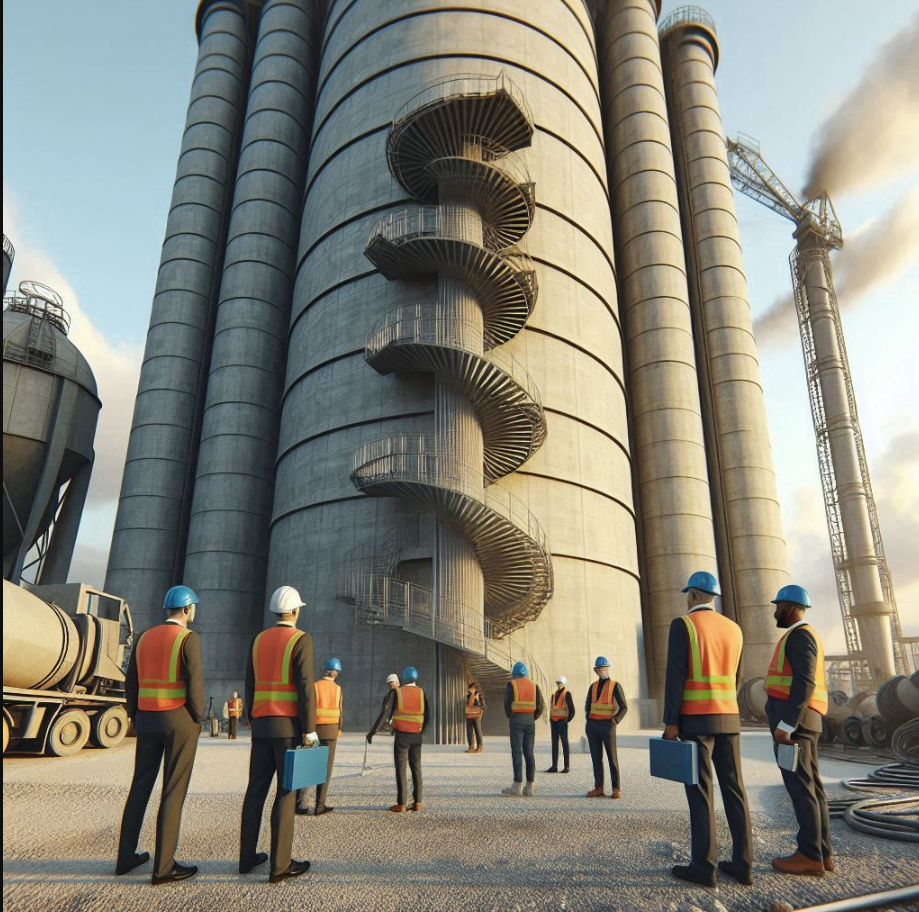Contents
Comprehensive Practical Guide to Cement Silo Maintenance

TO Download this post and all the books and excel sheets and my personal notes and presentations I collected about cement industry in the last 30 years click the below paypal link
Maintaining a cement silo is critical for ensuring the longevity and efficiency of the equipment. Regular maintenance prevents costly repairs, reduces downtime, and ensures the quality of stored cement. This guide will cover the steps involved in cement silo maintenance, the required tools, the number of workers needed, the estimated cost, equipment models and brands, and real-life case studies.
Steps for Cement Silo Maintenance
1. Inspection
a. Visual Inspection
- Frequency: Monthly
- Procedure:
- Check for any visible cracks or damage to the silo structure.
- Inspect the roof for any signs of leakage or wear.
- Examine the silo walls for corrosion or rust.
- Inspect the discharge gate for proper operation.
- Check the condition of the safety ladders and guardrails.
b. Structural Inspection
- Frequency: Annually
- Procedure:
- Engage a structural engineer to assess the integrity of the silo.
- Use ultrasonic thickness gauges to measure the thickness of the silo walls.
- Conduct a non-destructive testing (NDT) to identify hidden flaws.
2. Cleaning
a. Interior Cleaning
- Frequency: Every six months
- Procedure:
- Empty the silo completely.
- Use industrial vacuums or compressed air to remove residual cement.
- For stubborn residues, use high-pressure water jets or mechanical brushes.
b. Exterior Cleaning
- Frequency: Quarterly
- Procedure:
- Use a pressure washer to clean the exterior surface.
- Ensure proper drainage to prevent water accumulation.
3. Lubrication
- Frequency: Monthly
- Procedure:
- Lubricate all moving parts such as the discharge gate, bearings, and hinges.
- Use a high-quality industrial lubricant suitable for cement applications.
4. Repair and Replacement
a. Crack Repair
- Procedure:
- Clean the crack area thoroughly.
- Apply epoxy or cement-based crack filler.
- Allow it to cure as per the manufacturer’s instructions.
b. Component Replacement
- Procedure:
- Replace worn-out components like valves, sensors, and discharge gates.
- Ensure compatibility with existing silo specifications.
5. Safety Checks
- Frequency: Monthly
- Procedure:
- Test all safety devices like pressure relief valves and emergency shut-off systems.
- Ensure all safety signs and labels are clearly visible and legible.
Required Tools and Equipment
- Ultrasonic Thickness Gauge
- Model: Dakota Ultrasonics MMX-7
- Industrial Vacuum
- Model: Nilfisk IVT1000CR
- High-Pressure Washer
- Brand: Karcher HD 9/50 Pe Cage
- Lubrication Equipment
- Brand: Lincoln Industrial 1134
- Epoxy Crack Filler
- Brand: Sika Sikadur-52
Required Number of Workers
- Inspection: 2 workers (1 structural engineer, 1 assistant)
- Cleaning: 4 workers (2 for interior, 2 for exterior)
- Lubrication: 1 worker
- Repair and Replacement: 2 workers
- Safety Checks: 2 workers
Estimated Cost
- Inspection:
- Visual: $200/month
- Structural: $1,500/year
- Cleaning:
- Interior: $800/cleaning
- Exterior: $400/cleaning
- Lubrication: $100/month
- Repair and Replacement: Variable, typically $500 – $2,000 per event
- Safety Checks: $150/month
Total Annual Estimated Cost: ~$15,000 – $20,000
Real-life Case Studies
Case Study 1: AFrica pacific Cement Company
Africa Pacific Cement Company undertook a comprehensive maintenance program for their silos. They performed regular inspections, cleaning, and timely repairs. Over three years, they reduced unplanned downtime by 30% and extended the life of their silos by an estimated 10 years. The investment in maintenance paid off by significantly lowering operational disruptions and maintaining product quality.
Case Study 2: El Torra Construction Materials
EL Tora Construction Materials experienced frequent clogging and discharge issues. After implementing a robust maintenance schedule, including monthly lubrication and quarterly inspections, they saw a 50% reduction in clogging incidents. The company also reported savings of over $10,000 annually due to fewer emergency repairs.
References and Sources
- Dakota Ultrasonics: Dakota Ultrasonics MMX-7
- Nilfisk Industrial Vacuums: Nilfisk IVT1000CR
- Karcher Pressure Washers: Karcher HD 9/50 Pe Cage
- Lincoln Industrial: Lincoln Industrial 1134
- Sika Group: Sika Sikadur-52
By following these guidelines, companies can ensure their cement silos are well-maintained, reducing the risk of costly repairs and enhancing the efficiency of their operations. Regular maintenance not only extends the life of the equipment but also ensures the quality and consistency of the stored cement.
